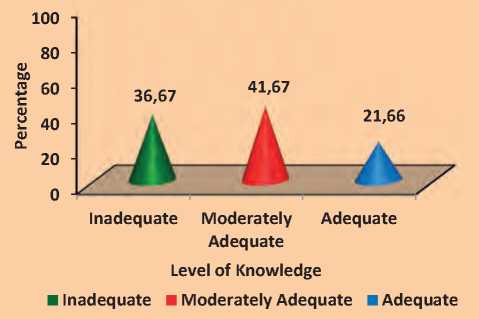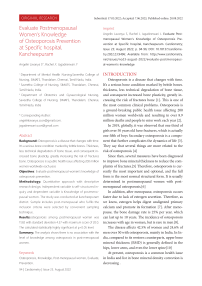Evaluate postmenopausal women's knowledge of osteoporosis prevention at specific hospital, Kancheepuram
Автор: Lavanya S.A., Rachel J., Jagadeeswari J.
Журнал: Cardiometry @cardiometry
Рубрика: Original research
Статья в выпуске: 23, 2022 года.
Бесплатный доступ
Background: Osteoporosis is a disease that changes with time. It’s a serious bone condition marked by brittle bones. Thickness, less technical degradation of bone tissue, and consequent increased bone plasticity, greatly increasing the risk of fractures bone. Osteoporosis is a public health issue affecting 200 million women worldwide each year. Objectives: Evaluate postmenopausal women’s knowledge of osteoporosis prevention. Methodology: Quantitative approach with descriptive research design. Independent variable is self-structured inquiry and dependent variable is Knowledge of postmenopausal women. The study was conducted at kancheepuram district. Sample includes post-menopausal who fulfils the inclusion criteria were selected by convenient sampling technique. Results:osteoporosis among postmenopausal women was 11.82 with standard deviation 4.57 with maximum score of 20.0. The calculated statistically highly significant at p
Osteoporosis, knowledge, postmenopausal women, evaluate, prevention
Короткий адрес: https://sciup.org/148326574
IDR: 148326574 | DOI: 10.18137/cardiometry.2022.23.9496
Текст научной статьи Evaluate postmenopausal women's knowledge of osteoporosis prevention at specific hospital, Kancheepuram
Angelin Lavanya S, Rachel J, Jagadeeswari J. Evaluate Postmenopausal Women’s Knowledge of Osteoporosis Prevention at Specific hospital, Kancheepuram. Cardiometry; Issue 23; August 2022; p. 94-96; DOI: 10.18137/cardiome-try.2022.23.9496; Available from: http://www.cardiometry. net/issues/no23-august-2022/evaluate-postmenopaus-al-women's-knowledge
Osteoporosis is a disease that changes with time. It’s a serious bone condition marked by brittle bones. thickness, less technical degradation of bone tissue, and consequent increased bone plasticity, greatly increasing the risk of fractures bone [1]. This is one of the most common clinical problems. Osteoporosis is a ground-breaking public health issue affecting 200 million women worldwide and resulting in over 8.9 million deaths and people to miss work each year [2].
In 2019, globally, it was observed that one third of girls over 50 years old have fractures, which is actually one fifth of boys Secondary osteoporosis is a component that further complicates the dynamics of life [3]. They say that several things are more related to the risk of osteoporosis [4]
Since then, several measures have been diagnosed to improve bone mineral thickness to reduce the complaints of fractures.[5] Therefore, osteoporosis is currently the most important and optional, and the full form is the most normal structural form. It is usually determined in postmenopausal women with postmenopausal osteoporosis.[6]
In addition, after menopause, osteoporosis occurs faster due to lack of estrogen secretion. Therefore, as we know, estrogen helps digest undigested primary calcium and promote its formation [7]. After menopause, the bone damage rate is 25% per year, which can last up to 10 years. The incidence of osteoporosis increases with age in women, but is rare in men [8].
The disease affects 42.5% of women and 24.6% of men over 50 with osteoporosis, mainly in India. In India, compared to its western counterparts, upper bone mineral thickness (BMD) is generally defined in the hips, lower arms, and even the lower spine[10]
At present, osteoporosis is a common health issue in India and list in bone mineral density correction is decreasing .
In India, postmenopausal women with extreme fracture sizes have been measured for mortality and morbidity, so they must first be screened for osteoporosis [10]. Most of the meager screening efforts are hampered by inattention to the plight of rural girls after menopause, meaning we choose to study behavior and better understand these women. To be healthy after menopause, it is vital to actively consider your modern core. Until now, people have been paying attention and trying to minimize and understand this statistical gaps [11]
Osteoporosis is now a condition that reduces bone thickness, reduces specificity, and makes bones appear brittle [12]. This is when osteoporosis manifests itself by pushing up abnormally compressible, cotton-like cancellous bone, and erectile menopause can be the target of osteoporosis. The basal and basal areas most affected in the skeletal system. Salt[13]. Menopause is a wonderful attribute of daily maturity, manifested by the permanent cessation of the female cycle due to estrogen secretion leading to estrogen restriction [14]
MATERIALS AND METHODS
This study took a quantitative approach with a descriptive research design was used and selected tool to evaluate the knowledge on osteoporosis to post-menopausal women. After obtaining permission to conduct the study was obtained from the Principal, Faculty of Nursing, Institutional Ethics Committee and the Head of the Department of hospital, Saveetha Hospital selected 60 samples. The sample was selected by convenient sampling technique. The investigator introduced and explained purpose of the study samples and obtains the written informed consent. The post-menopausal women in out patient clinic. The tools consisted of two sections, Section- a deals with demographic variables, which includes Age, Religion, Education, Occupation, Types of family. Section - b deals with structured questionnaire to evaluate the knowledge on post-menopausal women. It consists of 20 multiple choice questions.
RESULTS AND DISCUSSION
Section A: Sample characteristics
The present study results is (58 %) post-menopausal women in the study with regards to the age in 4550 years, majority (60%) of post-menopausal women were based on Hindu (38%) Muslim (68%) majori- ty(64%) of post-menopausal women were non- literate. The majority (50%) of women were unemployed. majority (40%) of post- menopausal women having monthly income above Rs.4000-6000 And the major-ity(46 % ) belongs to both vegetarian and non vegetarian .
The Table 1 shows that 25(41.67%) had moderately adequate knowledge, 22(36.67%) inadequate knowledge 13(21.66%) adequate knowledge on osteoporosis among post menopausal women.
Table 1
Evaluate the knowledge on osteoporosis among post menopausal women
|
Level of Knowledge |
Number of patient |
percentage |
|
Inadequate Knowledge (≤50%) |
22 |
37% |
|
Moderately Adequate Knowledge (51 – 74%) |
25 |
41% |
|
Adequate Knowledge (>75%) |
13 |
23% |

The present study shows that evaluate the knowledge on prevention of osteoporosis to post-menopausal women, (22%) had inadequate knowledge (30%) had moderate knowledge and (58%) had adequate knowledge
These findings have been supported by a similar study conducted by veeramreddy (2018) evaluate the knowledge among post-menopausal women, Nellore. There have been found no significant difference between level of awareness regarding prevention of osteoporosis (2.25) at p<0.05 level of significance. There is no association [15].
Section C: Existing evaluate the knowledge on osteoporosis topost menopausal women
The Table 2 depicts that the mean score of knowledge on osteoporosis among post menopausal women was 11.82 with standard deviation 4.57 with minimum score of 0 and maximum score of 20.0
Table 2
Assessment of knowledge scores on osteoporosis among post menopausal women. N = 60
|
Knowledge |
Mean |
|
Minimum Score |
0.0 |
|
Maximum Score |
20.0 |
|
Mean |
11.82 |
|
Standard Deviation |
4.57 |
CONCLUSION
The present study shows that (58 %) post-menopausal women with regards to the age in 45-50 years, majority (60%) of post-menopausal women were based on Hindu (38%) Muslim (68%) majority (64%) of post-menopausal women were non- literate. The majority (50%) of women were unemployed . majority (40%) of post- menopausal women having monthly income above Rs.4000-6000 And the majority (46 % ) belongs to both vegetarian and non vegetarian .evaluate the knowledge on prevention of osteoporosis to post-menopausal women, (22%) had inadequate knowledge (30%) had moderate knowledge and (58%) had adequate knowledge. The mean score of knowledge on osteoporosis among post menopausal women was 11.82 with standard deviation 4.57 with minimum score of 0 and maximum score of 20.0. Thus the finding of the present study revealed that there is no significant association but in the future all post natal women should gain knowledge about Osteoporosis. There are several menopausal ladies in the neighbourhood who don’t have enough information about soya bean supplements. In light of this, the researcher set out to evaluate the impact of soya bean supplementation on menopausal women living in a particular community area in the Kancheepuram district of Tamil Nadu’s somatic and vasomotor symptoms. Using the snowball sampling approach, 60 menopausal women with somatic and vasomotor symptoms who satisfied the inclusion criteria were chosen from the villages of Orathi and Kadaimalaputhur.
Список литературы Evaluate postmenopausal women's knowledge of osteoporosis prevention at specific hospital, Kancheepuram
- Pande, K., Pande, S., Tripathi, S., Kanoi, R., Thakur, A., &Patle, S. (2005). Poor knowledge about osteoporosis in learned Indian women. JAPI, 53(1)
- Thulkar, J., & Singh, S. (2015). Overview of research studies on osteoporosis in menopausal women since the last decade. Journal of mid-life health, 6(3), 104.
- Kotak, P., &Vaghela, S. Assessment of knowledge on osteoporosis among menopausal women residing at rural areas of Kutch: A cross-sectional study.
- Thulkar, J., & Singh, S. (2015). Overview of research studies on osteoporosis in menopausal women since the last decade. Journal of mid-life health, 6(3), 104.
- Senthilraja, M., Cherian, K. E., Jebasingh, F. K., Kapoor, N., Paul, T. V., &Asha, H. S. (2019). Journal of family medicine and primary care, 8(4), 1374.
- Sachan, S., &KamliPrakash, U. G. (2016). International Journal of Medical Science and Public Health, 5(09), 1929.
- Baba, U., Khan, N., & Ali, I. (2017). An assessment of knowledge and level of awareness among postmenopausal women regarding management and control of osteoporosis.
- Sahni, B. S. (2018). International Journal of Research & Review, 5, 73-8.
- Janiszewska, M., Firlej, E., Żołnierczuk-Kieliszek, D., &Dziedzic, M. (2016). Knowledge about osteoporosis prevention among women screened by bone densitometry.Przegladmenopauzalny= Menopause review, 15(2), 96.
- Kaur, R., Begum, N. S., &Kaur, A. (2015). Punjab 2014. Asian Journal of Nursing Education and Research, 5(1), 140-145.
- Smets, J., Shevroja, E., Hügle, T., Leslie, W. D., & Hans, D. (2021). Machine LearningSolutions for Osteoporosis— A Review. Journal of Bone and Mineral Research.(10)
- Turcotte, A. F., O’Connor, S., Morin, S. N., Gibbs, J. C., Willie, B. M., Jean, S., & Gagnon, C. (2021). Association between obesity and risk of fracture, bone mineral density and bone quality in adults: A systematic review and meta-analysis. PloS one, 16(6), e0252487.
- Rundasa, D. T., Ayisa, A. A., &Mekonen, E. G. (2022). Knowledge, health belief, and associated factors towards the prevention of osteoporosis among post-menopausal women in Metu Town, southwest Ethiopia: A community-based cross-sectional study. International Journal of Orthopaedic and Trauma Nursing, 45, 100905.
- Shakil, A., Gimpel, N. E., Rizvi, H., Siddiqui, Z., Ohagi, E., Billmeier, T. M., & Foster, B. (2010). Awareness and prevention of osteoporosis among South Asian women. Journal of community health, 35(4), 392-397.
- Veeramreddy (2018) Knowledge about osteoporosis: assessment, correlates and outcomes. Osteoporosis International, 16(2), 115-127.


